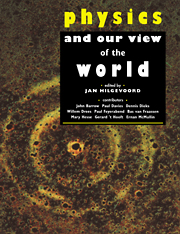Book contents
- Frontmatter
- Contents
- Foreword
- Introduction
- 1 Questioning the answers or Stumbling upon good and bad Theories of Everything
- 2 Theories of Everything
- 3 The scientific view of the world: introduction
- 4 Enlarging the known world
- 5 The world of empiricism
- 6 Has the scientific view of the world a special status compared with other views?
- 7 Quantum theory and our view of the world
- 8 Interpretation of science; science as interpretation
- 9 Problems in debates about physics and religion
- 10 The mind of God
- 11 The sources of models for God: metaphysics or metaphor?
- Discussion
- Notes on contributors
- Bibliography
- Index
8 - Interpretation of science; science as interpretation
Published online by Cambridge University Press: 04 December 2009
- Frontmatter
- Contents
- Foreword
- Introduction
- 1 Questioning the answers or Stumbling upon good and bad Theories of Everything
- 2 Theories of Everything
- 3 The scientific view of the world: introduction
- 4 Enlarging the known world
- 5 The world of empiricism
- 6 Has the scientific view of the world a special status compared with other views?
- 7 Quantum theory and our view of the world
- 8 Interpretation of science; science as interpretation
- 9 Problems in debates about physics and religion
- 10 The mind of God
- 11 The sources of models for God: metaphysics or metaphor?
- Discussion
- Notes on contributors
- Bibliography
- Index
Summary
In this chapter I shall address the realism—empiricism opposition only obliquely. My focus will be on the question: to what extent can we conceive of science as representation? Both the natural sciences and the fine arts, throughout their respective histories, have been characterized as activities whose primary goal is representation. This view is now widely rejected in the philosophy of art. Science too is now often characterized as interpretation rather than representation of nature.
While Paul Feyerabend's early writings were crucially involved in the (re-)emergence of scientific realism, they were always somewhat subversive of that view as well. After all, the summaries and slogans of realism have often depicted science as straightforward representation of nature, while Feyerabend's papers had as perhaps their most salient theme the role of interpretation at all levels of scientific observation and theorizing. Our contributions to this book are therefore not likely to be confrontational — all the more so because one of my main inspirations in this topic area has been Feyerabend's Wissenschaft als Kunst.
I want to explore three levels of interpretation: the interpretative elements in a work, the interpretations which these works admit, and finally our interpretation of the very activity in which these works are produced.
Information
- Type
- Chapter
- Information
- Physics and our View of the World , pp. 169 - 187Publisher: Cambridge University PressPrint publication year: 1994
Accessibility standard: Unknown
Why this information is here
This section outlines the accessibility features of this content - including support for screen readers, full keyboard navigation and high-contrast display options. This may not be relevant for you.Accessibility Information
- 15
- Cited by
